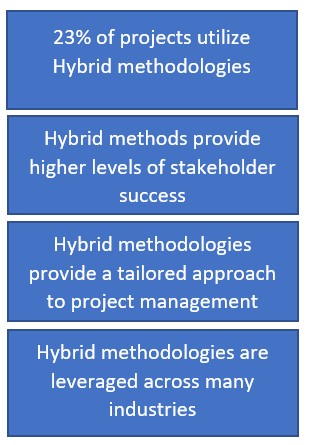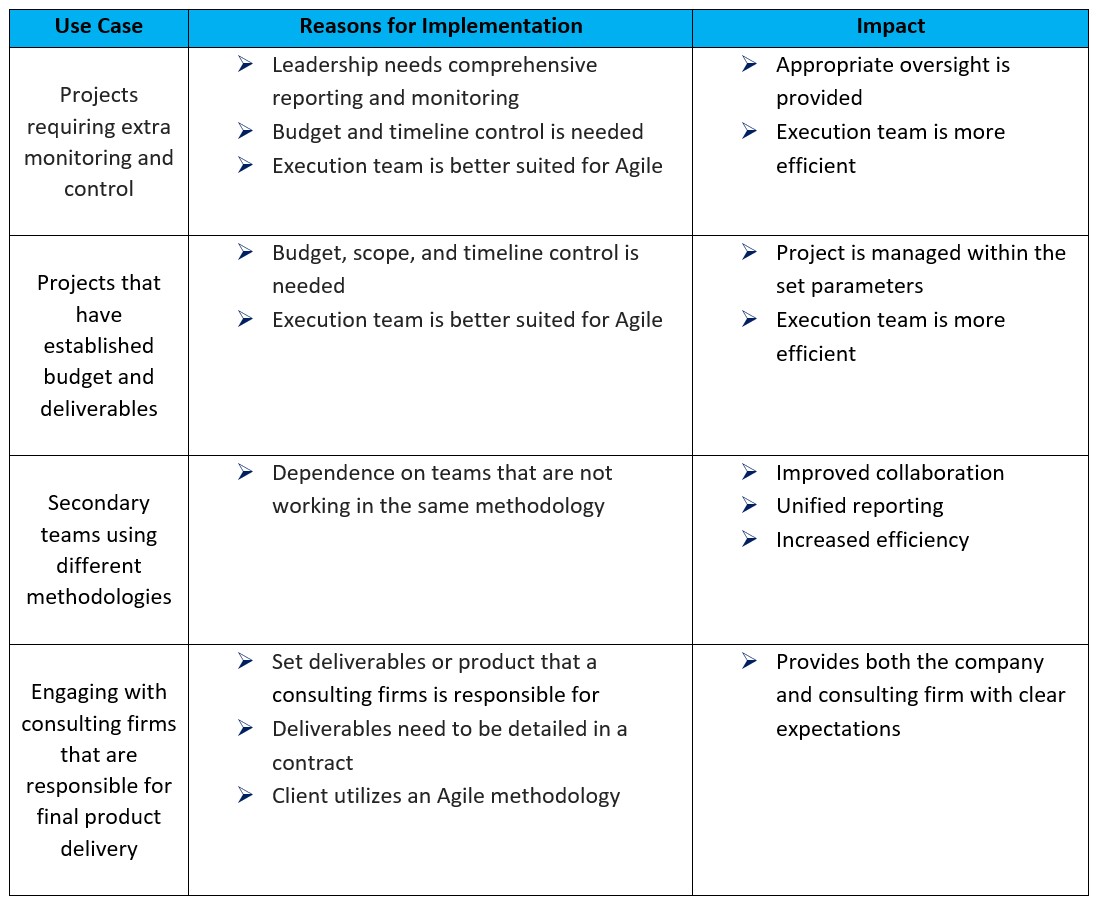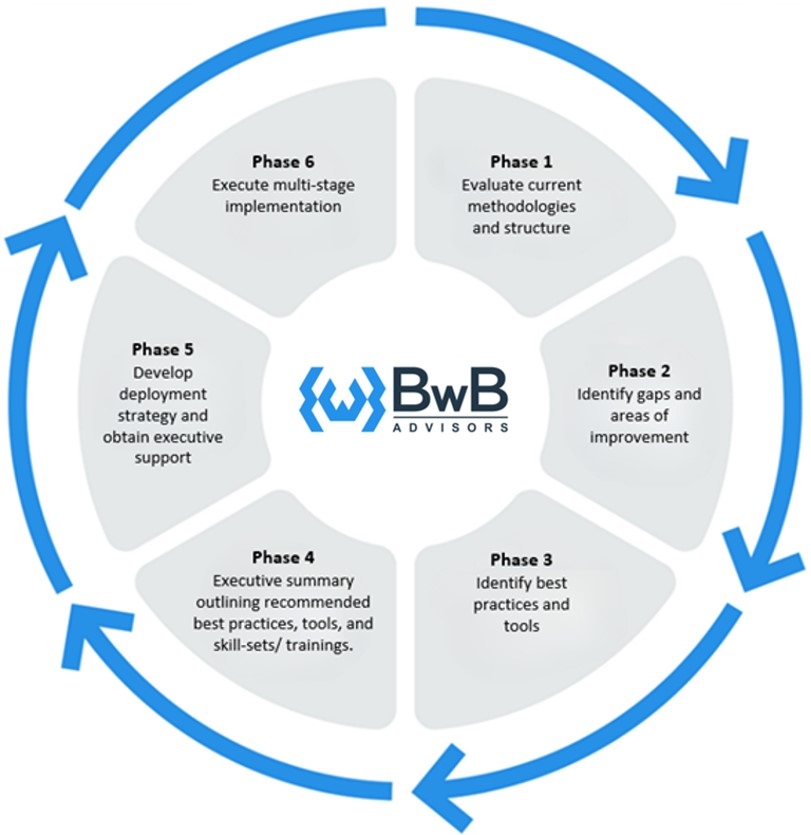Project Management Office - Hybrid
Hybrid methodologies combine the best features from various methodologies to create a custom solution tailored to individual organizations or projects. In this installment of our Project Management Briefings series, we will focus on Hybrid Methodologies, their key benefits, business impact & use cases.
Overview:
Hybrid methodologies are a relatively new process for project management that leverages key features from both predictive and adaptive approaches (such as Waterfall and Agile respectively). By giving teams the ability to mix and match the most useful components from each, teams can fully optimize their workflows and ensure maximum efficiency. It is important to point out that this is different from blended methodologies which combines various frameworks from the same methodology. The first mainstream Hybrid methodology was formalized in 2011 as a way to utilize the best features of both the Waterfall and Scrum methodologies. While the Hybrid approach is still new in comparison to other methodologies, it has quickly become popular across many industries. According to a study conducted by PMI (Project Management Institute), 23% of all projects across the IT, telecom, energy, healthcare, construction, and government industries utilize Hybrid methodologies [2].
different from blended methodologies which combines various frameworks from the same methodology. The first mainstream Hybrid methodology was formalized in 2011 as a way to utilize the best features of both the Waterfall and Scrum methodologies. While the Hybrid approach is still new in comparison to other methodologies, it has quickly become popular across many industries. According to a study conducted by PMI (Project Management Institute), 23% of all projects across the IT, telecom, energy, healthcare, construction, and government industries utilize Hybrid methodologies [2].
As Hybrid methodologies pull from both Predictive and Adaptive methodologies, it is important to understand the key features of each; so let’s recap the basics from our previous articles. Predictive methods (such as Waterfall) follow a linear and sequential process, utilizing a set of steps/ stages that follow a pre-specified order. These methodologies are typically front-loaded to rely on careful planning, detailed documentation, and consecutive execution. Adaptive methods (such as Agile) follow an iterative approach that focuses on continuous releases and incorporating customer feedback into every iteration. Projects are broken up into sprints, at the end of each, stakeholders and the team review their work and make adjustments for the next sprint. Combining key features from both approaches can eliminate unnecessary tasks while significantly improving efficiency and flexibility. For example, a Hybrid methodology could blend Waterfall and Scrum in a way that leverages Waterfall for planning and outlining requirements, while using Agile for the design, development, and testing phases. Additionally, in cases where the team is better suited for Agile but management still requires additional oversight, a Hybrid methodology provides an excellent alternative.
Key Benefits:
Hybrid project management methodologies offer a variety of benefits based on the solution as well as the supporting best-practices and tools being implemented. Some of the most common benefits to Hybrid methodologies include:
Adaptability: The flexibility of Hybrid methodologies can help teams quickly adapt to changing requirements and ensure that their approach is aligned with the project's goals. Furthermore, if the team identifies that something isn’t working well, the methodology can be adjusted to increase performance.
Increased efficiency: By combining the premier elements from different methodologies, a Hybrid approach can help teams work more efficiently and effectively. For example, a Hybrid approach could use Waterfall methods for initial project planning, and Agile methods for project execution.
Improved collaboration: Hybrid methodologies can improve collaboration between team members by providing common language and frameworks, which can mitigate any issues when working with ununified methodologies (i.e. when teams running different management methodologies need to work together). This helps to ensure that everyone is on the same page and that productivity is maximized.
Tailored approach: Hybrid methodologies are tailored to meet the specific needs of a project. This means that teams can pick and choose elements from different methodologies that will work best for their specific project needs.
Enhanced quality: By tailoring the methodology to the project’s specific needs, the overall quality can be enhanced while simultaneously reducing risk. A good example of this is working with secondary teams within the organization that are following a different methodology. We will go into more detail on this in the next installment of our PMB series (Alignment Vs. Ununified Methodologies).
Use Cases:
While a substantial number of organizations are moving toward Hybrid methodologies, there are industries and use cases where implementing a Hybrid methodology will be most effective. Some of the most common industries that leverage Hybrid methodologies are IT, manufacturing, and marketing as a blended approach provides the adaptability needed to be efficient in these fields.
See the table below for examples of Hybrid's uses cases and impact within the IT industry:

Implementation Best-Practices:
When implementing a Hybrid methodology there are certain factors that need to be taken into consideration. The corporate culture and leadership’s perspective needs to be accounted for as Hybrid methodologies vary substantially from other methodologies. Additionally, most organizations do not leverage one methodology, so it is important to know how to merge the various methodologies in order to get the most efficient results from your teams. By correctly utilizing a Hybrid approach, teams working with different methodologies can easily find common ground and collaborate more seamlessly.
Another important factor is utilizing the correct tools; common tools such as Collaboration, Testing, Code Control, and Planning tools are all leveraged. Typically with a Hybrid method, the tools that correspond to the process in each methodology are used. For example, if Agile elements are being used for capturing requirements, tools such as Azure DevOps or Jira would be utilized.
Limitations:
While Hybrid methodologies have many benefits, there are cases where utilizing them isn’t the best option. Similarly to adaptive methodologies (namely Agile), certain parts of the decision-making process get pushed down to the correct levels to allow teams to respond to changes more efficiently. As this structure is very different from predictive methodologies, leadership often has issues with relinquishing control. Secondly, while Hybrid methodologies allow for a tailored approach to projects, it requires that the company or team defines how each aspect of the project will be handled (reporting, documentation, etc.). Therefore, there are instances where a Hybrid solution will work, but the project is better suited for a methodology that already has well-defined frameworks and processes in place. Thirdly, projects that require steps to be completed in a certain order (e.g. construction projects) will not work as well in a Hybrid setting as the adaptive components will be underutilized and could complicate processes unnecessarily.
The stages in a Hybrid methodology are tailored to the team implementing it, and are highly dependent on the methodologies it draws from. This means that the project stages can vary drastically. As such, careful consideration is needed when choosing the components of each parent methodology in order to achieve the best results. BwB’s extensive expertise can help guide you through this process and ensure success.
We will continue to discuss the benefits and use cases of various methodologies throughout our Project Management Briefings series.
BwB Advisor’s Methodology for Optimizing Project Management:
As the business world continues to evolve, the approach to project management needs to evolve in parallel. Regardless of your organization’s industry, utilizing the correct best practices and management methodologies can help reduce costs and risk, maximize productivity, and improve the quality of deliverables. Nevertheless, organizations should proceed cautiously in deciding what to adopt — one size does not fit all.
At the BwB Advisors our Project Management Optimization Methodology (PMOM) follows a 6 phase process that provides a comprehensive roadmap from identifying key best practices, tools, and methodologies. This helps to ensure a successful implementation that leads to improved productivity, reduced costs, and increased project success.

To learn more about our PMOM, click here or reach out to us to see how our PMOM can help you by clicking here.
October 2023 / Insights / By: Michael T. Casarona
References:
[1] Kalaba, J. (2023, July 21). What is Hybrid Project Management? - plaky. Plaky Learn. https://plaky.com/learn/project-management/hybrid-project-management/
[2] Ozhiganov, I. (2019, August 9). Why and how to use a hybrid project management approach. Medium. https://medium.com/azoft/why-and-how-to-use-a-hybrid-project-management-approach-4d58b45e9a84#:~:text=Although%20Waterfall%20and%20Agile%20sound%20more%20familiar%2C%20a,used%20the%20%E2%80%9Chybrid%E2%80%9D%20method%20in%2023%25%20of%20projects.
